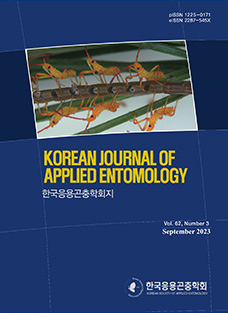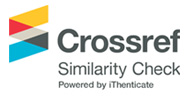The family Stathmopodidae, characterized by clusters of long setae on the hind tibia, was first reported by Edward Meyrick in 1913 (Meyrick, 1913;Sinev, 2015). This family comprises more than 408 species in 44 genera worldwide, with distributions concentrated particularly in the Indo-Australian and Afrotropical regions, while very few species have been reported from South America and the temperate zones of the Holarctic region (Koster and Sinev, 2003;van Nieukerken et al., 2011).
Among these, the genus StathmopodaHerrich-Schäffer, 1853 comprises the largest proportion, with more than 240 species, and exhibits high ecological diversity, with larvae feeding on a wide variety of materials such as crops, mosses, spider eggs, and fern sporese (Austin, 1985;Terada, 2016;Shen and Hsu, 2023). However, because adult individuals are extremely small and often morphologically similar to one another, species identification is challenging, which has led to limited research on this group (Kim et al., 2017).
Furthermore, while 14 species have been reported in the Stathmopoda –from the Korean Peninsula, over 24 species have been recorded in Japan (Terada, 2016; Park et al., 2018; Kim et al., 2024). Depending on the circumstances, members of this family can become serious agricultural pests or serve as a means of biological control, nevertheless, research on this genus remains particularly insufficient in the Korean Peninsula. In this study, we report Stathmopoda atridorsalisTerada, 2014 and S. dorsioculellaTerada, 2014 from the Korean Peninsula for the first time, confirming their distribution.
Materials and Methods
Specimens were collected using light traps equipped with mercury vapor lamps (220 V/400 W) and black lights (12 V/20 W). Collected specimens were pinned through the thorax and wings, and then dried in an oven at 50°C for over three weeks. Dissection for identification followed the protocol described by Kim et al. (2017), using an EZ4 stereomicroscope (Leica, Germany). Specimens for which sex could not be determined due to a missing abdomen were designated as ‘individual’. Adults and genitalia were photographed using a Leica S8APO stereomicroscope (Leica, Germany) equipped with a Tucsen Dhyana 400 DC digital camera (Tucsen, China) and a Leica LED 5000 HDI dome illuminator (Leica, Germany). Images taken at multiple focal points were combined using Mosaic software (Tucsen, China) and Helicon Focus software (Helicon Soft, Ukraine), with backgrounds subsequently removed using Adobe Photoshop 2024 (Adobe, USA).
Taxonomic accounts
Family Stathmopodidae Meyrick, 1913
Stathmopodidae Meyrick, 1913: 310. Type genus. Stathmopoda Herrich-Schäffer
Genus StathmopodaHerrich-Schäffer, 1853
StathmopodaHerrich-Schäffer, 1853: 54. Type species. Phalaena (Tinea) pedella Linneaus, 1761
BoocaraButler, 1880: 562. Type species. Boocara skelloniButler, 1880
PlacostolaMeyrick, 1887: 280. Type species. Placostola diplaspisMeyrick, 1887
ErinedaBusck, 1909: 94. Type species. Erineda elyellaBusck, 1909
AgrioscelisMeyrick, 1913: 96. Type species. Agrioscelis tacitaMeyrick, 1913
KakivoriaNagano, 1916: 138. Type species. Kakivoria flavofasciataNagano, 1916
Diagnosis. Adult. wing expanse 10.0–20.0 mm. Head generally yellow to ocher. Labial palpus upcurved, sharply pointed at the apex. Thorax generally yellow to brown, caudal margin differently colored from the ground color. Abdomen with scales at each segment caudally. Forewing generally yellow to brown, either uniformly colored or mixed with multiple colors; fringes generally similar to ground color, occasionally differing at the apex. Hindwing brown to dark brown; frenulum single in male, three to four in female. Male genitalia. Uncus with densely setae at the lateral margin. Gnathos as long as uncus, generally tongue-shaped. Cucullus oval-shaped or triangular, densely setae internally. Sacculus with setae at the ventral margin. Female genitalia. Papillae anales weakly sclerotized with some short setae. Eighth abdominal segment sclerotized, setae along the caudal margin. Apophyses posteriores approximately twice the length of apophyses anteriores. Corpus bursae sac-like, one or two signa present.
Stathmopoda atridorsalisTerada, 2014 (신칭: 갈색가슴꼭 지나방) (Fig. 1A–E)
Stathmopoda atridorsalisTerada, 2014: 109–110. Type locality. Japan
Diagnosis. This species is similar to S. pedella (Linnaeus) and S. stimulata Meyrick but is easily distinguished by the marking and color of the wing. In. S. pedella, the forewings are ocher with the third fascia reaching the costal, the brownish black blotch near the apex, and the hindwings and fringes are brown. In S. stimulata, the center of the third fascia is pale white, and a well-developed black streak is present near the apex. But in this species, the wings and fringes are pale ocher, the third fascia does not reach the costal, and the pale brown streak near the apex is weakly developed. In the male genitalia, this species is close to S. neohexatyla (Li and Wang) but has differences from cucullus and aedeagus. In S. neohexatyla, cucullus is narrow oval-shaped, and six spiniform cornuti are located at the aedeagus. But in this species, cucullus is subtriangular, and there are more than 10 cornuti present at the aedeagus.
Material examined. One individual, Mt. Sobaek, Youngpunggun, GB, Korea, 13.vii.1998, Paek.; one individual, Mt. Changbai, Changbaixian, Malugou, China, 07.viii.2002, Park.; one individual, Mt. Goheon, Ulju-gun, Ulsan-si, GB, Korea, 01. viii.2012, Bae Y.S.; one male and two individuals, Mt. Gilgok, Onmae-ro 987, Uljin-gun, GB, Korea, 08–09.vii.2024, Han and Ra, gen. slide. No. IPE JBNU-13287/ I.W. Jeong.
Description. Adult. wing expanse 12.1–15.8 mm. Head yellowish white. Antenna pale ocher. Labial palpus pale ocher. Thorax. Tegula grayish brown from base to middle, pale brown from middle to apex, with ocherous edges. Thorax grayish brown, pale ocherous blotch at the caudal margin, caudally darker grayish brown spot at end of caudal margin. Abdomen ocher with pale ocherous scales caudally at each segment. Forewing pale ocher; costal grayish brown; grayish brown fascia from base to 1/6; two grayish brown blotches at 1/3 and 2/3; first streak pale brown on CuP; second streak brown, originating from first blotch and gradually widening towards second blotch; third streak brown, weakly developed. Originating from the second blotch to near apex, fringes from base to 3/5 grayish brown, from 3/5 to near the apex pale ocher, black at the apex. Hindwing grayish brown; fringes grayish brown. Male genitalia. Uncus caudally tapering, blunt apex, numerous setae at the lateral margin. Gnathos caudally tapering, as long as uncus. Valva with round apex; costa slightly convex, with some setae; cucullus 3.5 times longer than uncus, large oval-shaped with numerous setae inwardly; sacculus sclerotized, slightly convex at median, some setae ventrally. Vinculum elongated with an acute apex; saccus 1/3 length of uncus. Anellar lobes well-developed, sclerotized, narrow ovalshaped with some setae. Aedeagus three times longer than uncus, more than 10 short spiniform cornuti arranged in a row on vesica; weakly sclerotized subrectangular plate near the base.
Host. Unknown.
Distribution. Korea (South; new record), China (new record), Japan.
Stathmopoda dorsioculellaTerada, 2014 (신칭: 외눈무늬꼭 지나방) (Fig. 2A–F)
Stathmopoda dorsioculellaTerada, 2014: 109–110. Type locality. Japan
Diagnosis. This species is close to S. stimulata but has differences in the marking of the forewing and thorax. In S. stimulata, there are brown blotches at 1/3 and 2/3 of the ocherous forewing, additionally, the ocherous thorax features symmetrical brown blotches at 1/2. A pale grayish-brown spot is present on the caudal margin. But in this species, there is no blotch on the ocherous forewing, also, the brown thorax has grayish brown fascia at 1/2, and there is an ocherous blotch along with a pale grayish brown spot on the caudal margin. In male genitalia, this species is similar to S. neohexatyla, but has differences from sacculus and aedeagus. In S. neohexatyla, the sacculus extends to 1/5 of the cucullus, and the aedeagus contains six or fewer cornuti. However, in this species, the sacculus extends only to the base of the cucullus, and the aedeagus contains seven or more cornuti.
Material examined. One individual, Gamsan-ri, Andeokmyeon, Seogwipo-si, JJ, Korea, 03.ix.2012; two males, Samduri 47, Guneo-myeon, Wando-gun, JN, Korea, 30.viii.2024, J. Park, gen. slide. No. IPE JBNU-13278, 13280/ I.W. Jeong.
Description. Adult. wing expanse 13.0-15.8 mm. Head grayish ocher. Antenna yellowish white; scape pale ocher dorsally. Labial palpus yellowish white. Thorax. Tegula brown with grayish brown blotch on the inner side of the middle, ocher at the apex. Thorax brown; prothorax dark ocher, grayish brown caudally; grayish brown blotch symmetrically on the cephalic margin; pale grayish brown triangular blotch at cephalic 1/4; arched grayish brown fascia darker caudally at the middle; ocherous blotch at the caudal margin; pale grayish ocherous spot darker caudally at the end of caudal margin. Abdomen ocher, with pale ocherous scales at each segment caudally. Forewing mostly grayish ocher, narrower and paler toward the apex; five streaks running; first streak dark grayish ocher, broad, from the base to the anal angle along posterior, not reaching posterior; second streak broad grayish brown, from base to 2/7 along costal; third streak broad grayish brown, from anal angle to median of CuP; fourth streak brown, along CuP; fifth streak originating from 2/3 extending near apex, dark pale brown towards the apex; fringes grayish ocher, pale gray at the apex. Hindwing grayish ocher darker towards the apex; fringes grayish ocher. Male genitalia. Uncus tapering caudally with a blunt apex, numerous setae at the lateral margin. Gnathos slightly shorter than uncus, narrow, round at the apex. Valva round at apex; costa slightly angled dorsally with some setae; cucullus longer than three times the length of the uncus, large oval-shaped with slightly angled at base 1/3, numerous setae inwardly; sacculus sclerotized, round at apex, with some setae ventrally. Vinculum elongated; saccus slightly longer than 1/3 length of uncus. Anellar lobes well-developed, weakly sclerotized, narrow oval-shaped. Aedeagus four times longer than uncus; structure composed of numerous triangular microspines, 1/3 length of aedeagus, on vesica; more than seven tooth-shaped cornuti connected at each end, forming a straight line; weakly sclerotized plate on vesica near the base.
Host. Unknown.
Distribution. Korea (South; new record), Japan.
Key to Species of the Genus Stathmopoda (based on forewing)
-
1. Forewing generally yellow to ocher ····························· 2
-
- Forewing generally gray to brown ······························· 11
-
2. Forewing without fascia or blotch ········· S. dorsioculella
-
- Forewing with fascia or blotch ······································ 3
-
3. Second and third fasciae connected with streak near costal margin ·········································································· 4
-
- Second and third fasciae connected with streak along posterior margin ···························································· 8
-
4. No streak originating from the third fascia and extending near the apex ·················································· S. pedella
-
- A streak originating from the third fascia and extending near the apex existent ···························································· 5
-
5. Fringes uniform color overall ·················· S. neohexatyla
-
- Fringes brownish black at the apex ································ 6
-
6. Forewing generally straight ····················· S. atridorsalis
-
- Forewing curved at the apex ·········································· 7
-
7. Forewing with a blotch on the 2/3 containing a white spot at the center ··············································· S. baegunica
-
- Forewing with a blotch on 2/3 without a spot S. stimulata
-
8. Third fascia without connecting to the costal ··············· 9
-
- Third fascia connecting with the costal ························ 10
-
9. A streak originating from the third fascia and extending near the apex exists ······························ S. gemmiconsuta
-
- No streak originating from the third fascia and extending near the apex ··············································· S. flavescens
-
10. A streak originating from the third fascia and extending to the apex existing ·································· S. euryzoster
-
- No streak originating from the third fascia and extending to the apex ························································ S. commoda
-
11. Ground color of forewing almost gray ····················· 12
-
- Ground color of forewing almost brown ······················ 13
-
12. Gray margin from 1/3 to apex ············· S. haematosema
-
- Gray margin from 1/5 to apex ···················· S. moriutiella
-
13. Ground color of forewing brown ·············· S. masinissa
-
- Ground color of forewing brown from about 1/3 to the apex ···················································································· 14
-
14. Forewing yellow from base to 1/3··········· S. auriferella
-
- Forewing multicolored from base to 1/3·· ···················· 15
-
15. Second fascia with flat base ····················· S. opticaspis
-
- Second fascia with convex base ······················ S. persona











 KSAE
KSAE





